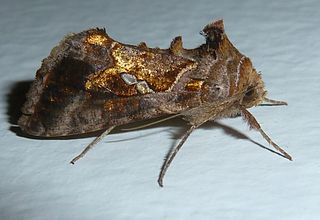
The autumnal rustic is a moth of the family Noctuidae. The species was first described by Eugenius Johann Christoph Esper in 1788. It was previously placed in the genus Paradiarsia. It is found in northern and western Europe and North Africa.

Tramea limbata is a species of dragonfly in the family Libellulidae. Its common names include black marsh trotter, ferruginous glider and voyaging glider.

Stagmomantis limbata, common name bordered mantis, bosque mantis, Arizona mantis, or New Mexico praying mantis, is a species of praying mantis native to North America, most prevalent in the south-western United States. This beneficial insect is green or beige in color and grows up to around 3 inches long.

Chrysodeixis chalcites, the tomato looper or golden twin-spot moth, is a moth of the family Noctuidae, subfamily Plusiinae. It mainly lives in southern Europe, the Levant and tropical Africa, but can be seen migrating across much of Europe. In 2013, it was spotted in Canada. It is an important horticultural pest in New Zealand.

Mythimna turca, the double line, is a moth of the family Noctuidae. The species was first described by Carl Linnaeus in 1761. It is found in Europe. The eastern expansion extends through northern Asia and central Asia to northern China, Korea and Japan. It rises to a height of about 700 metres in the Alps.
Autophila is a genus of moths in the family Erebidae.
Hyperfrontia is a genus of moths of the family Noctuidae.

Mimeusemia is a genus of moths of the family Noctuidae first described by Arthur Gardiner Butler in 1875. Species are found in Japan, India, Sri Lanka and Myanmar.

Stenodrina is a genus of moths of the family Noctuidae.
Autophila pauli is a moth of the family Erebidae first described by Charles Boursin in 1940. It is found in arid areas of Jordan, Israel, Sinai, and Egypt.
Autophila anaphanes is a moth of the family Erebidae first described by Charles Boursin in 1940. It is found in the eastern part of the Mediterranean, including the Balkans, Cyprus, Turkey, Lebanon and Israel.
Autophila ligaminosa is a moth of the family Erebidae first described by Eduard Friedrich Eversmann in 1851. It is found from the Near East and Middle East to south-eastern Russia, the Balkans, Afghanistan, the United Arab Emirates and Oman.
Autophila cerealis is a moth of the family Erebidae first described by Otto Staudinger in 1871. It is found in the Near East and Middle East, from Turkey and the Levant to Central Asia and the Arabian Peninsula.
Autophila libanotica is a moth of the family Erebidae first described by Otto Staudinger in 1901. It is found from Turkey to Turkmenistan, Afghanistan, Pakistan Iran, northern Greece, Lebanon and Israel.
Autophila einsleri is a moth of the family Erebidae first described by Hans Georg Amsel in 1935. It is found in Turkey, Jordan, Cyprus, the Caucasus, Syria, Iraq, Iran, Lebanon, Israel, Turkmenistan and Oman.

Chazaria incarnata is a species of moth of the family Noctuidae. It is found on the Canary Islands and on the Iberian Peninsula, east to Italy, Serbia, Romania, Bulgaria, North Macedonia and Greece. Further east it is found to southern and eastern Russia in the north and Turkey, the Dead Sea region of Israel and Iran.

Orthosia limbata is a moth of the family Noctuidae. It is found in Korea, Japan, China, Taiwan and Nepal.

Cicindela albissima, commonly called the Coral Pink Sand Dunes tiger beetle is a species of tiger beetle endemic to Coral Pink Sand Dunes State Park in southern Utah, United States. It was originally described by Rumpp in 1962 as the subspecies Cicindela limbata albissima, but mitochondrial DNA, along with the species' morphological and geographical distinctiveness, have shown that it is a separate species. C. albissima can be distinguished from other Cicindela species by its restricted range and lack of pigmentation on its elytra.
The Toxocampinae are a subfamily of moths in the family Erebidae. Moths in the subfamily typically have a primitive form of genital claspers similar to those of some subfamilies of the Noctuidae.









